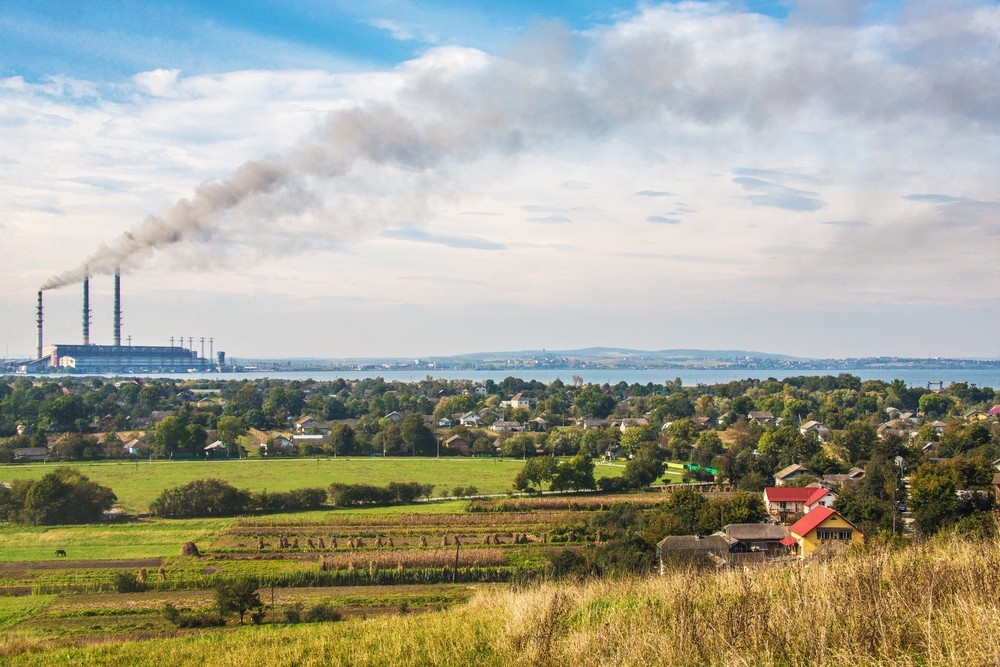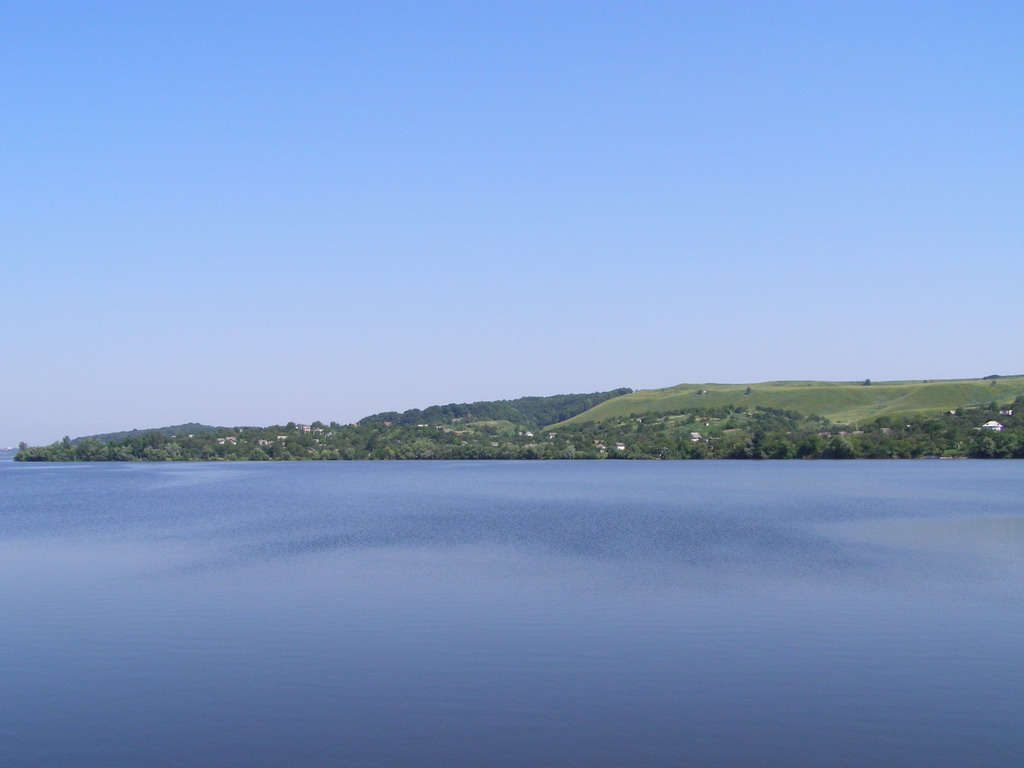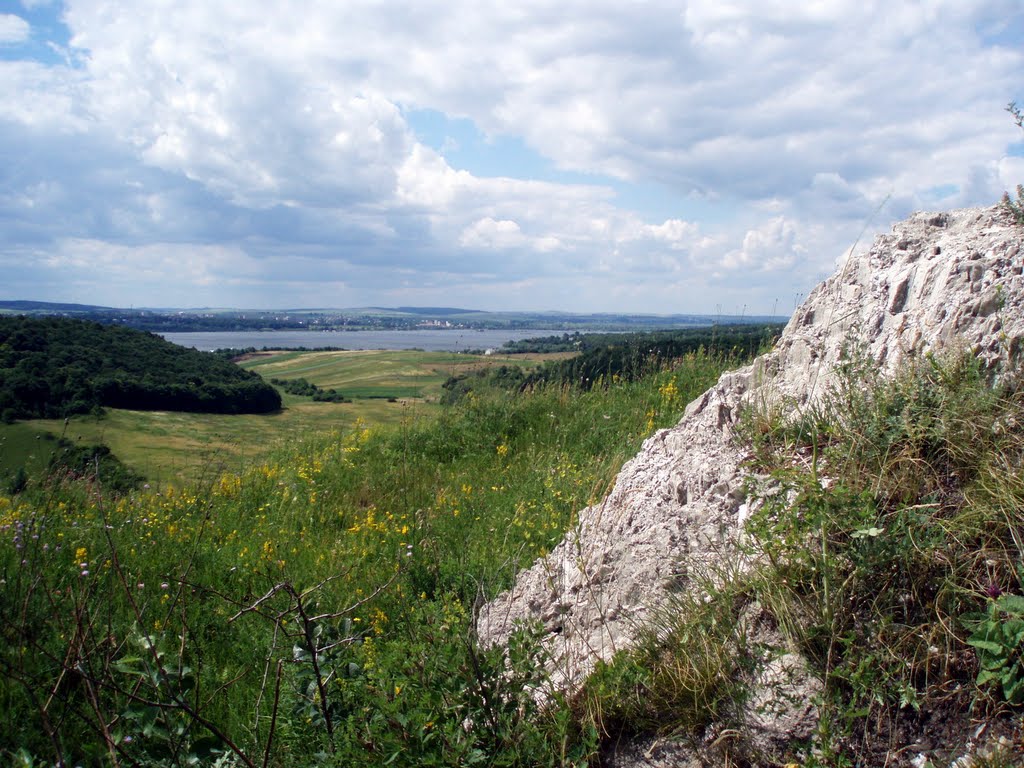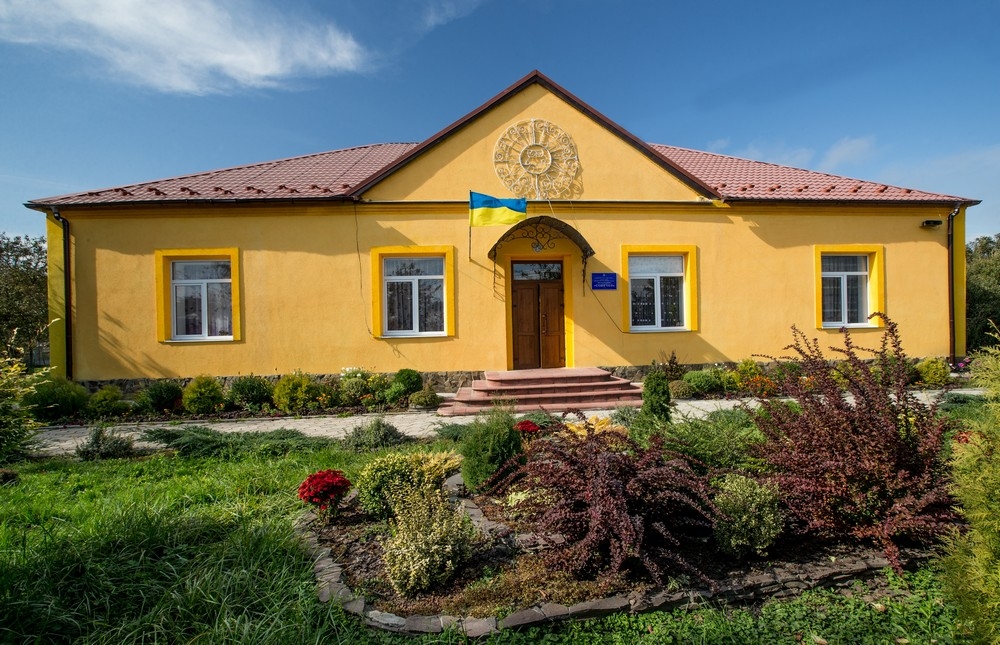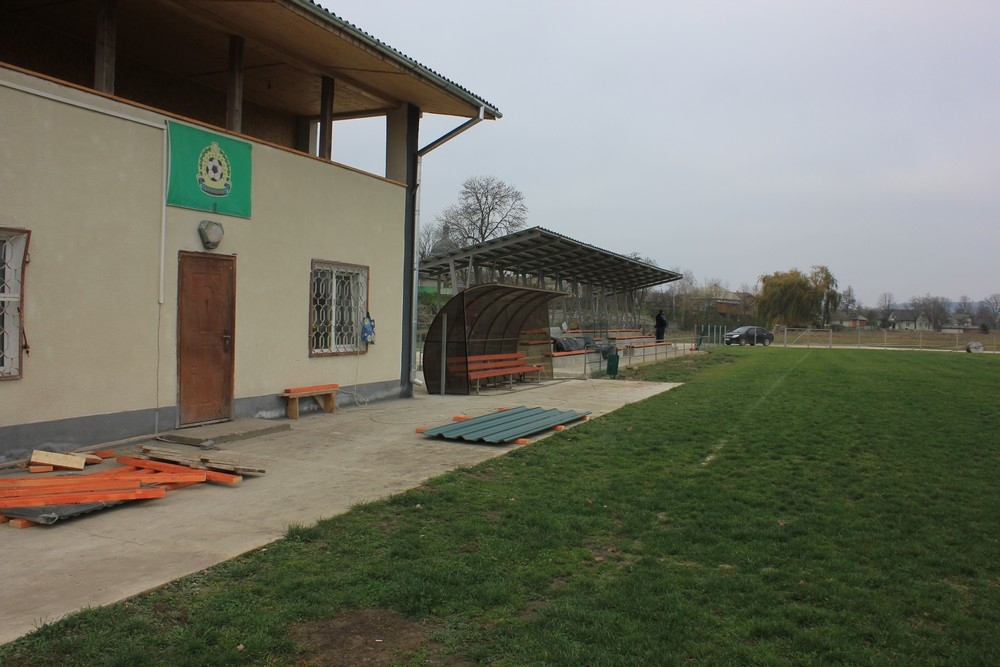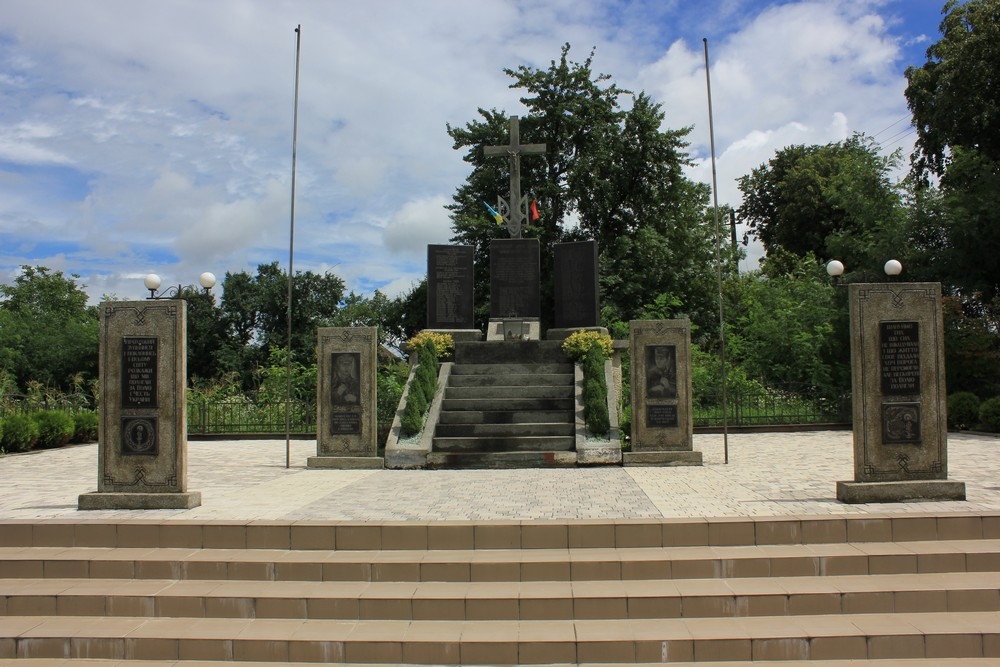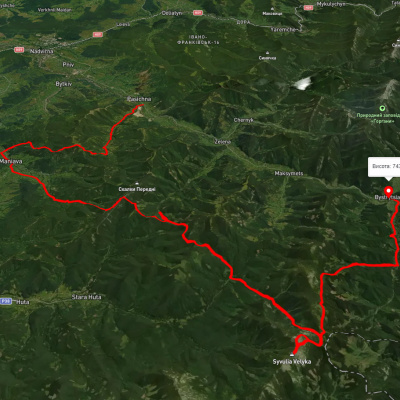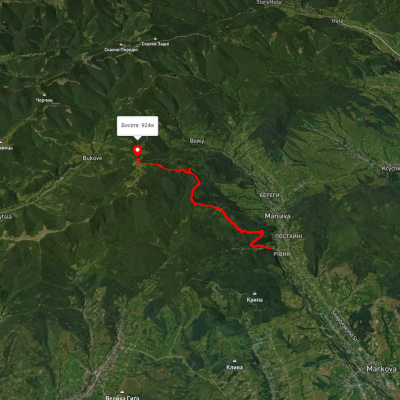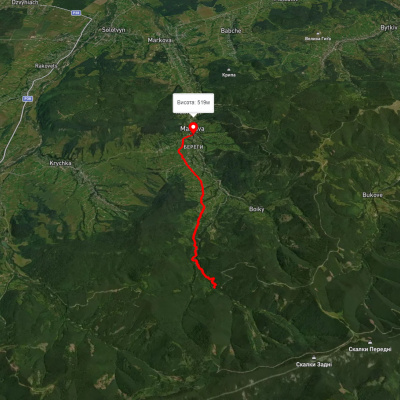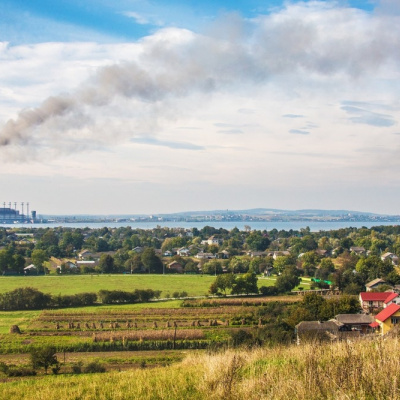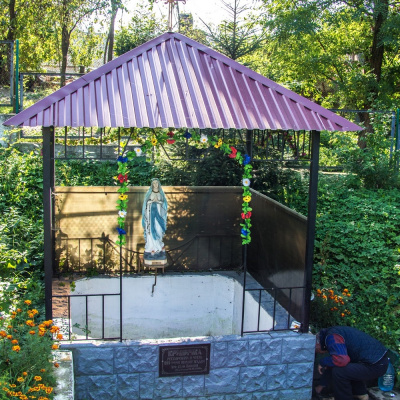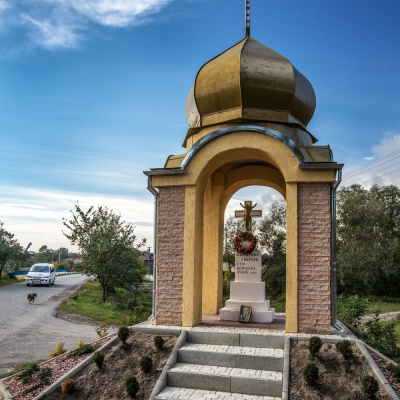Bovshiv is divided into tracts: Vyhyn, Horb, Dvoryshche, Kut 1 and Kut 2, Obolon, Pidhay, Pidstav, Seredivka. There are 20 streets in the village, 1400 people live there, and there are 570 yards. Typical surnames of the residents are Bartkiv, Vilchyk, Kurdydydyk, Kurliak, Martyniv, Murafa, Pauk, Tsymbalistyi, Shuvar.
My dear Bovshiv, you are the only one for me,
Like a father, like life itself,
Like the bread of the earth, like a swan song,
If you were not there, I would fall into oblivion.
Bovshiv is one of the oldest settlements in the
Halych district. The first mention of the village dates back to 1153 in the Ipatiev Chronicle. A charter dated March 8, 1402, certifies that the landowner Agneta donated "her village, Malyi Bovshiv, in the Halych district to Archbishop Jacob Strepa." There is still a legend in the village about the pier, which is identified with the chronicle's "Bolshyi Prychal" and hints at the origin of the village name Bovshiv. Only its first component, "bolshyi," has been preserved, which later transformed into "Bolshev," then into "Bovshev," and finally into "Bovshiv."
In 1962, during the construction of the Burshtyn thermal power plant, during excavations Larysa Krushelnytska discovered traces of the Latenian culture (second and first centuries BC) on the left bank of the Hnyla Lypa near Bovshiv, which was apparently inhabited by Dacian tribes who came from the territory of modern Romania. The archaeologists explored an area of 2700 m², where they found 8 dugouts with a clay oven, 47 outbuildings and pits of 19 hearths, and collected a large collection of stucco and pottery, fragments of stucco dishes typical of the Prague-type culture (VI-VII centuries). The unique finds include a fingered bronze fibula. Among the finds, the icon of the Annunciation (XI century) stood out. Perhaps it was this ancient Russian settlement that gave rise to Bovshiv.
The settlement of the Lipizzan culture (III-I centuries AD), whose representatives were engaged in agriculture and cattle breeding, is of great value for Slavic archeology.
On the territory of the village there is a unique complex natural monument of national importance in Ukraine -
Kasova Hora, a 65-hectare site that is part of the
Galician National Reserve Nature Park. More than 300 species of plants grow here, some of them unique - plants from the late Tertiary period. The protected area of Kasova Hora is home to the most beautiful feather grass and long-leaved feather grass, a number of rare endemic and relict plant species (Danish astragalus, Ternopil cornflower, low sedge, Zapalovych's chicory buttercup and other plants). Many plants are listed in the Red Book of Ukraine.
The people of Bovshivka have preserved a number of legends and traditions about Kasova Hora, shrouded in the secrets of past centuries. According to one of them, Prince Danylo Halytskyi kept money, gold, and jewelry in the mountain's natural caches. Closer to the truth is the version that the Bovshiv boyar hid his treasury in the labyrinths of karst caves.
However, the passage to the cave was blocked and as a result, the jewelry and money remained inside the mountain forever, and so it got its name - Kasova. Some researchers believed that an ancient Russian monastery stood on the plateau, which is located on one of the mountain slopes. Since ancient times, the entire mountainous strip of the monument has been dotted with rare stones with a lace of thin veins called alabaster.
One of Burshtyn's owners noticed them in the 30s of the XIX century and decided to start an alabaster industry. Alabaster products were made not only by several private craftsmen, but also by a local workshop owned by a cooperative.
Among the products made of alabaster, candlesticks, ashtrays, vases, inkpots, powder boxes, and sculptures of animals, fish, and birds were especially popular. Finished products were sold partly locally and also abroad. Alabaster objects were especially in demand in the mid-1930s.
Many local residents sold and delivered raw materials to famous sculptors. This craft greatly depleted the natural resources of the mineral. During the First World War, Russians dug trenches on Kasova Hora, and its surface was covered with bullet and shell casings as a result of fierce fighting. The peaks of Kasova Hora offer magnificent views of the Dniester, the Transnistrian valley, Halych, Bilshivtsi, and the Burshtyn Reservoir.
The village of Bovshiv has been a historical and patriotic village since ancient times and to this day. In the fall of 1939, Soviet troops came to Prykarpattia on a "liberation mission". On the instructions of the new government, Ukrainian societies and organizations, many of which were active in Bovshiv, were liquidated.
Each family is a part of the history of the village and Ukraine. Thus, in the turbulent years of the struggle against the Bolsheviks, more than 100 families suffered from the Moscow-Bolshevik occupier. In 1942-1944, Bovshiv was occupied by the Nazis. During the three war years, 78 people were taken to Germany for forced labor, and 35 yards were burned. On July 25, 1944, units of the Soviet Army occupied the village. In total, 37 residents of Bovshivka died on the fronts of World War II.
In the postwar years, UPA military groups operated in the surrounding forests. Residents of Bovshiv were among the first to undergo military training in the Carpathians. About a hundred local residents fought in the insurgent army. The residents of Bovshiv became the bush leaders of the UPA. Between 1946 and 1952, 52 families (169 people) were deported to Siberia for their nationalist beliefs. In those years, 90 villagers died for the freedom and independence of Ukraine.
The Bolsheviks burned down houses, killed residents, destroyed culture - Ukrainian queues - but patriotism and love for Ukraine made the people of Bovshivka unbreakable. They managed to preserve the traditions, culture, and indomitable spirit of Ukrainians.
The village of Bovshiv began to develop in the days of independent Ukraine. At the end of 1989, the Taras Shevchenko Ukrainian Language Society and the Ukrainian Women's Union were founded in Bovshiv, and in 1990, the branches of the NRU and the URP were established.
In 1992, the residents of Bovshiv celebrated the 840th anniversary of the first written mention of the village. At the same time, a museum of Bovshiv history was created at the local school, which contains exhibits of excavations, alabaster stone products, and historical memorabilia about the village and its villagers.
The village is fully gasified, and a water supply system has been installed to provide the villagers with water. The documentation for the sewerage network has been developed.
Since 2006 and until now, Hanna Ochkur has been working as the village head. Through her hard work, she has contributed to the implementation of effective reforms that have yielded significant results in the development of Bovsheva village. Under her leadership, vital community issues are being addressed.
To eliminate landfills in the village and prevent pollution, a garbage truck was purchased to serve Bovshiv and the surrounding villages of the district. Many measures have been taken to eliminate the harmful effects of water in various tracts of the village. Drainage trays and footpaths were installed along the streets. The streets of the village were asphalted.
A natural spring was restored and a chapel was built on it. A bus stop pavilion was installed. Two children's playgrounds were installed in the village for children's leisure and development. Bovshiv has a school of I-II levels with 115 pupils.
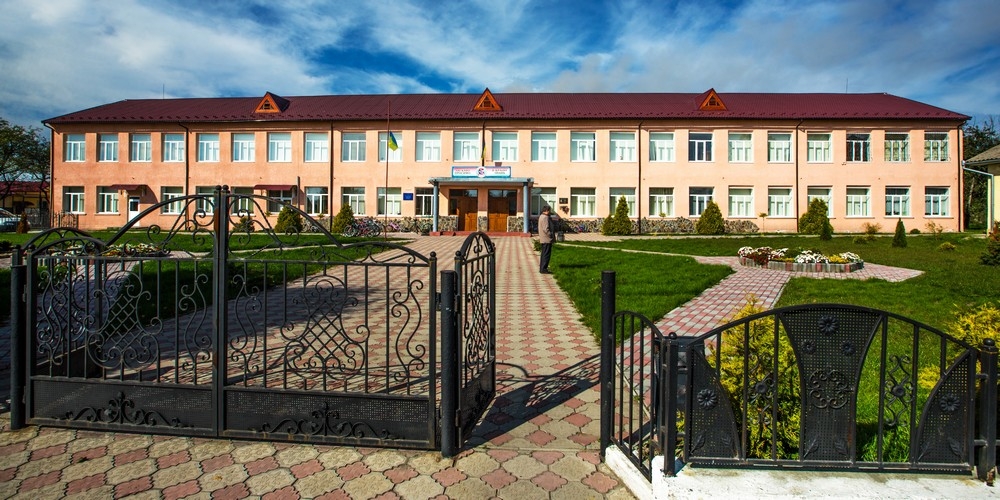
In 2015-2016, the school was overhauled: indoor toilets were installed, new equipment, desks, school supplies, sports equipment were purchased for school classes, a computer classroom with permanent Internet access was equipped, and a school canteen was purchased for which dishes, refrigerators, new stoves, hot and cold water, and sewerage systems were installed. The school has an after-school program, as well as clubs and sections. The gym has been renovated and equipped with the latest exercise equipment and sports equipment. There is a chapel in the school building, where the parish priest of the UGCC village, Father Leontiy Nastashynsky, holds weekly liturgies and retreats for school students. Together with their spiritual director, the children pray for Ukraine and for the soldiers who are defending our country in the East. Excursions to different parts of Ukraine are organized for students at the expense of the local budget.
Bovshiv has a wonderful kindergarten "Sonechko" with 50 seats. In 2015-2017, the premises were overhauled. The roof was replaced, the walls were insulated, sewer and water pipes were replaced, furniture, toys, dishes, and a computer were purchased. Spacious playrooms, cozy bedrooms with comfortable beds were equipped, and a sports and games room was added, where children have classes and holidays. With the assistance of the management of the plant, a playground was built in the kindergarten yard.
In 2015, the village opened a new medical facility - an outpatient clinic of general family medicine, which houses a physical therapy room, a dental office, a child examination room, equipped with the most modern dental equipment and devices for physical therapy. The doctors have a cardiograph, an electronic baby scale, a changing table and many other medical equipment.
The leisure center in Bovshiv is the community center, which hosts public holidays, celebrations of important dates, parties and meetings. The house of culture has undergone major repairs. All rooms in the 2-storey building are heated. Windows and doors were replaced, floor heating was installed in the auditorium and dance hall, new modern chairs, stage costumes, lighting, new microphones and musical equipment were purchased.
The Edelweiss dance and choreographic group under the direction of professional director Nadiia Tuz, which was awarded the title of "Exemplary" in 2017, operates at the House of Culture. Various sets of costumes were purchased for the team at the expense of the local budget. The dance group performs on major stages in Ukraine and Europe and participates in various festivals.
The villagers attach great importance to sports. The village has a volleyball court, a playground with outdoor exercise equipment, a fenced village stadium with spectator stands, a 2-storey locker room for football teams equipped with showers, a toilet, and a terrace for fans.
On June 20, 2016, the event that all the sports youth of the village had been waiting for took place - the grand opening and consecration of the artificial turf mini-football field, where students and youth of the village train on a regular basis. For decades, football has been a popular sport in Bovshiv. Currently, it is the Kasova Football Club, which participates in the 2nd League of the regional championship and wins prizes. The team is partially supported by the local budget.
The pride of the village is the Church of the Descent of the Holy Spirit, which, even during the Bolshevik occupation, was always functioning thanks to the people of Bovshivka. It was built in 1885 on the foundation of the old church. It is wooden, single-domed, and cruciform in plan. It was consecrated during a canonical visitation in 1888 by Bishop Julian Peles of Stanyslav, and the second time it was renovated in 1906 and consecrated by Metropolitan A. Sheptytsky.
In 1996, at the expense of the residents of Bovshiv, construction of a new church began next to the old one, which was consecrated in 2006. The iconostasis from the old church was restored and moved to the new one. From time to time the old church bells call to the liturgy, announcing the good and bad news of the people of Bovshivka.
In the church yard, parishioners installed two wooden one-armed crosses on the occasion of the 92nd anniversary of the Holy Spirit Church (1977) and the 1000th anniversary of the baptism of Kyivska Pysa (1988). The stone sign in honor of the abolition of serfdom in the churchyard was erected in 1888 and restored in 1990. It is a single-armed Latin cross made of marble chips.
In order to preserve historical memory, the villagers of Bovshivka honor all the monuments of the village's history. In 1987, a monument was erected in the center of the village in the courtyard of the House of Culture to the villagers who died on the fronts of World War II, with 35 names of the dead engraved on the slab.
In 1990, a monument to Taras Shevchenko was erected at the initiative of the NRU, the newest organizations of the village, and at the expense of the community. It was updated and restored in 2018. The grave site at the village cemetery was landscaped, where UPA soldiers who died in Bovshiv in battles with the German occupiers and Bolshevik NKVD troops in 1942-1952 are buried. 36 graves are fenced with a concrete curb and metal chain.
The village cemetery also restored the grave of the Ukrainian Sich Riflemen, where three Sich Riflemen are buried. In 1920-30, a cross made of sandstone stood on the site of the grave. After the arrival of the Bolsheviks, it was destroyed. In the mid-1980s, the remains of a former Sich Rifleman Savka, a native of Bovshev, who lived in Ivano-Frankivsk for the last years of his life and died there, were reburied in the mass grave. In the early 1990s, the grave was landscaped by building a low earthen mound in the shape of a cut-off pyramid and installing a Latin cross made of marble chips. A plaque with the inscription was attached to the cross: "To the fighters for the freedom of Ukraine: We irrigated our native land with blood, gave our lives to it, so that you could warm it with love and carry love into the future."
In the center of Bovshev there is a symbolic grave to the fighters for the freedom of Ukraine, dug in 1995, on a pedestal there is a one-armed cross with a trident attached and three steles with the names of fellow villagers who died in the struggle for the freedom of Ukraine (91 people).
In 1923, at the crossroads of 3 roads, near the place where the village tavern used to be, the women of the village erected the Cross of Sobriety as a sign of the fight against alcohol. Men were brought here to renounce alcohol consumption. In 2012, a chapel was built over the cross and flowers were planted.
On all sides at the entrance to the village, crosses have been standing for decades as guardians, blessing the villagers on their happy journey, protecting the fields from the elements. A memorial sign to the fallen pilots was erected on the bank of the Hnyla Lypa River in the Seredivka village tract. It was installed at the site of the crash of a MIG-29 UB military aircraft, which crashed over the village during a mission: "On this spot, on June 15, 1995, the crew of the MIG-29 UB aircraft died while performing a flight mission: Major Kozlov Anatolii Hennadiiovych and Captain Zakhozhyi Serhii Yevhenovych. The village also has a village library and 7 retail establishments that provide the villagers with everything they need. The pride of the village is the natives of our village. They have gone down in the history of Ukraine and the village. Among them are historical figures, scientists, scholars, doctors and composers.
- Bardngula Paraskoviia Matviivna (pseudonym: Tamara; 3.11.1926-1946, Nimshyn) - district leader of the Red Cross.
- Kurdydyk Anatolii Petrovych (1905-2001) - son of Fr. Petro Kurdydyk, a native of Bovshiv, journalist, writer.
- Kurdydyk Yaroslav Petrovych (1909-1990) - son of Fr. Petro Kurdydyk, a native of Bovshov, journalist, writer.
- Lokhotskyi Ivan (pseudonyms "Ivas", "Bolsh", "Ruchai"; 1922-9.09.1950) - head of the propaganda department of the Bilshivtsi district leadership of the OUN.
- Makariy Roman (pseudonym "Stryi"; 1923-26.05.1948, Nimshyn village) - Head of the Propaganda Department of the OUN district leadership.
- Masliak Irii (pseudonym "Holub"; 1924-1949) - a reference officer of the propaganda department of the OUN district leadership.
- Martyniv Orest Fedorovych (born 26.02.44) - singer, Honored Worker of Arts.
- Murafa Mykhailo (born on 9.09.1947) - artist, member of the Union of Artists of Ukraine.
- Parashchyn Omelian (1923-1953) - UPA maceman.
- Seniv Mykhailo (b. 22.04.1945) - Doctor of Philology. Sobkovych Roman (born 28.10.1951) - Candidate of Physical and Mathematical Sciences, Associate Professor, Head of the Department of Mathematics at the Precarpathian University.
- Stefanyshyn Yevhen (1924-30.02.1947) - head of the Burshtyn branch of the OUN.
- Stefanyshyn Myroslav (born 01.04.1927) - composer, Honored Artist of Ukraine,
- Bohdan Tsymbalistyi (born 3.10.1934) - public and political figure, member of the Ukrainian Helsinki Union.
- Cymbalisty Bohdan-Yaroslav (5.08.1919-16.08.1991) - Ukrainian professor of philosophical sciences, psychologist, public and cultural figure
- Cymbalisty Olha Leontivna (born in 1950) - Doctor of Medicine, lecturer at the Ivano-Frankivsk Medical Academy. She works in the field of pediatric pulmonology.
- Tsymbalistyi Yaroslav Ivanovych (b. 1940) - Candidate of Technical Sciences, lecturer at the Ivano-Frankivsk Technical University of Oil and Gas.
- Tsymbalistyi Yaroslav Ilkovych (born in 1955) - Colonel of Aviation. Yevhen Mykolaiovych Tsymbalistyi (1909-1966), singer (tenor), conductor and composer.
- Tsymbalistyi Yulian Mykolaiovych (1909-1966), founder of the Trembita Chapel.
- Shuvar Bohdan (born 13.05.1941) - Candidate of Mathematical Sciences, Associate Professor of the Department of Computational Mathematics and Programming at the Lviv Polytechnic Institute.
- Shuvar Ivan (b. 1954) - Head of the Department of Agriculture and Animal Husbandry at Lviv National Agrarian University, Doctor of Agricultural Sciences, Professor, "
- Roman Shuvar (b. 1951) - Candidate of Physical and Mathematical Sciences,
From 1957 to 2002, the Bovshiv Sugar Factory operated, processing hundreds of tons of sugar beet, generating large profits, employing residents of Bovshiv and surrounding villages. Over the years, a new village of sugar workers,
Zadnistrianske, grew up, which was subordinated to the Bovshivka village council.
In 1960-1968, the Burshtyn Thermal Power Plant was built, for the construction of which 806 hectares of land were transferred from Bovshiv. Burshtyn TPP is the largest taxpayer in the Galician region. More than 200 Bovshiv residents work in its facilities and workshops.
The second organization in the village is the Private Agrofirm "Bovshivska", which was formed on the basis of the former State Farm "Bovshivskyi". Bovshivska is engaged in growing grain crops, breeding dairy cattle, and raising pigs. The farm employs 30 villagers. Many Bovshivtsi residents work at Ivano-Frankivsk enterprises: Karpaty, Ivano-Frankivsk Cement and Slate Plant, and private enterprises in the district and region.
More than 400 villagers under the age of 40 live in the village. 200 residents are under the age of 18.
My native village is a magical world of childhood,
Where poplars reach to the sky, where the river is endless.
Every memory of you is so incredible,
Every thought about you is sweet and bitter.
My native village is my ups and downs.
The first boundless joy and tears of sorrow.
You have put down your eternal roots in me,
You have planted great treasures in my soul.
